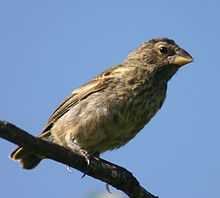Medium ground finch
| Medium ground finch | |
|---|---|
 | |
| Male | |
 | |
| Female | |
| Conservation status | |
| Scientific classification | |
| Kingdom: | Animalia |
| Phylum: | Chordata |
| Class: | Aves |
| Order: | Passeriformes |
| Family: | Thraupidae |
| Genus: | Geospiza |
| Species: | G. fortis |
| Binomial name | |
| Geospiza fortis Gould, 1837 | |
The medium ground finch (Geospiza fortis) is a species of bird in the Thraupidae family. It is endemic to the Galapagos Islands. Its natural habitats are subtropical or tropical dry forests and subtropical or tropical dry shrubland. One of Darwin's finches, the species was the first which scientists have observed evolving in real-time.
In 1977, a severe drought reduced the supply of seeds in the Galapagos. The finch, which normally preferred small and soft seeds, was forced to turn to harder larger seeds. Subsequently, there has been a 10% change in the size of beak for these finches in a couple of generations.
The population of medium ground finches has been experiencing inbreeding depression due to small population numbers. Inbreeding depression occurs when there is a decrease in fitness due to individuals mating with genetic relatives. Typically, this leads to a loss of genetic diversity and a reduction in heterozygosity. [2]
Description
Like the other members of its genus, the medium ground finch is strongly sexually dimorphic; the female's plumage is brown and streaky,[3] while male's is solid black, with white tips to the undertail coverts. The bird measures 12.5 cm (4.9 in) in length—which falls between the lengths of the small and large ground finches.[4][nb 1] The bill of this species is quite variable in size, though the length of the upper mandible is always greater than the depth of the bill at its base.[4] The wing shape, on average, seems to change with ecological shifts. Different selective pressures act on the wing shape of the finches, such as natural and sexual selection. The males have shorter, rounder wings, which help with maneuvering around a female during sexual displays. [6]
Habitat and range
Endemic to the Galápagos,[7] the medium ground finch is found on ten islands: Baltra, Floreana, Isabela, Fernandina, Seymour, Pinzón, San Cristóbal, Santa Cruz, Santa Fé, and Santiago.[8]
Behavior
Feeding
The medium ground finch feeds primarily on seeds, although it is also known to eat flowers, buds, and young leaves, and the occasional insect. It forages either on the ground or in low vegetation.[3]
Predation
The medium ground finch has been under parasitism of Philornis downsi, as well as the avian pox virus (Poxvirus avium). Although outbreaks of the virus have been historically rare, in 2008 there was an outbreak that showed to be present in 50% of the finches tested. As a result, the finches have developed antibodies to fight specific invasive parasites. [9] The finches with the highest amount of antibodies tend to have the highest fitness, and therefore produce more viable offspring.
Note
- ↑ By convention, length is measured from the tip of the bill to the tip of the tail on a dead bird (or skin) laid on its back.[5]
References
| Wikimedia Commons has media related to Geospiza fortis. |
| Wikispecies has information related to: Geospiza fortis |
- ↑ BirdLife International (2012). "Geospiza fortis". IUCN Red List of Threatened Species. Version 2012.1. International Union for Conservation of Nature. Retrieved 16 August 2012.
- ↑ Markert, J, & Grant, P (2004). Neutral Locus Heterozygosity, Inbreeding, and Survival in Darwin’s Ground Finches (Geospiza fortis and G. scandens). Heredity, 306, 15.
- ↑ 3.0 3.1 Scott, Thomas, ed. (1996). Concise Encyclopedia Biology. Berlin, Germany: Walter de Gruyter. p. 510. ISBN 978-3-11-010661-9.
- ↑ 4.0 4.1 Swash & Still (2006), p. 102.
- ↑ Cramp, Stanley, ed. (1977). Handbook of the Birds of Europe, the Middle East and North Africa: Birds of the Western Palearctic, Volume 1, Ostrich to Ducks. Oxford University Press. p. 3. ISBN 978-0-19-857358-6.
- ↑ Vanhooydonck, B, & Herrel, A (2009). Wing Shape Variation in the Medium Ground Finch (Geospiza fortis): An Ecomorphological Approach. Biological Journal of the Linnean Society, 129, 38.
- ↑ Swash & Still (2006), p. 32.
- ↑ Swash & Still (2006), p. 152.
- ↑ Huber, S, & Owen, J (2010). Ecoimmunity in Darwin's Finches: Invasive Parasites Trigger Acquired Immunity in the Medium Ground Finch (Geospiza fortis). Public Library of Science, 5, 1-6.
Sources
Swash, Andy; Still, Rob (2006). Birds, Mammals and Reptiles of the Galapagos Islands: An Identification Guide. New Haven, CT, USA: Yale University Press. ISBN 978-0-300-11532-1.
